maintenance MITSUBISHI OUTLANDER SPORT 2014 3.G Owner's Manual
[x] Cancel search | Manufacturer: MITSUBISHI, Model Year: 2014, Model line: OUTLANDER SPORT, Model: MITSUBISHI OUTLANDER SPORT 2014 3.GPages: 384, PDF Size: 46.94 MB
Page 327 of 384
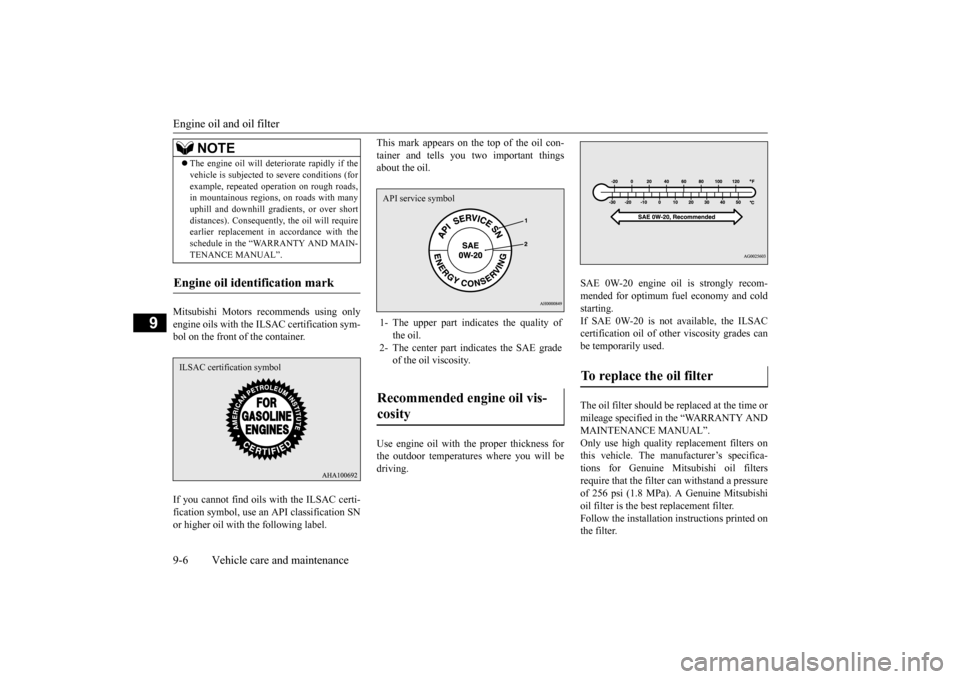
Engine oil and oil filter 9-6 Vehicle care and maintenance
9
Mitsubishi Motors recommends using only engine oils with the ILSAC certification sym- bol on the front of the container. If you cannot find oils with the ILSAC certi- fication symbol, use an API classification SN or higher oil with the following label.
This mark appears on the top of the oil con- tainer and tells you two important things about the oil. Use engine oil with the proper thickness for the outdoor temperatures where you will bedriving.
SAE 0W-20 engine oil is strongly recom- mended for optimum fuel economy and cold starting.If SAE 0W-20 is not available, the ILSAC certification oil of other viscosity grades can be temporarily used. The oil filter should be
replaced at the time or
mileage specified in the “WARRANTY AND MAINTENANCE MANUAL”.Only use high quality replacement filters on this vehicle. The manufacturer’s specifica- tions for Genuine Mitsubishi oil filtersrequire that the filter can withstand a pressure of 256 psi (1.8 MPa). A Genuine Mitsubishi oil filter is the best replacement filter.Follow the installation
instructions printed on
the filter.
The engine oil will deteriorate rapidly if the vehicle is subjected to severe conditions (for example, repeated operation on rough roads, in mountainous regions, on roads with many uphill and downhill gradients, or over shortdistances). Consequently, the oil will require earlier replacement in accordance with the schedule in the “WARRANTY AND MAIN-TENANCE MANUAL”.
Engine oil identification mark
NOTE
ILSAC certification symbol
1- The upper part indicates the quality of
the oil.
2- The center part indicates the SAE grade
of the oil viscosity.
Recommended engine oil vis- cosity API service symbol
To replace the oil filter
BK0202700US.bo
ok 6 ページ 2013年3月28日 木曜日 午前11時54分
Page 328 of 384
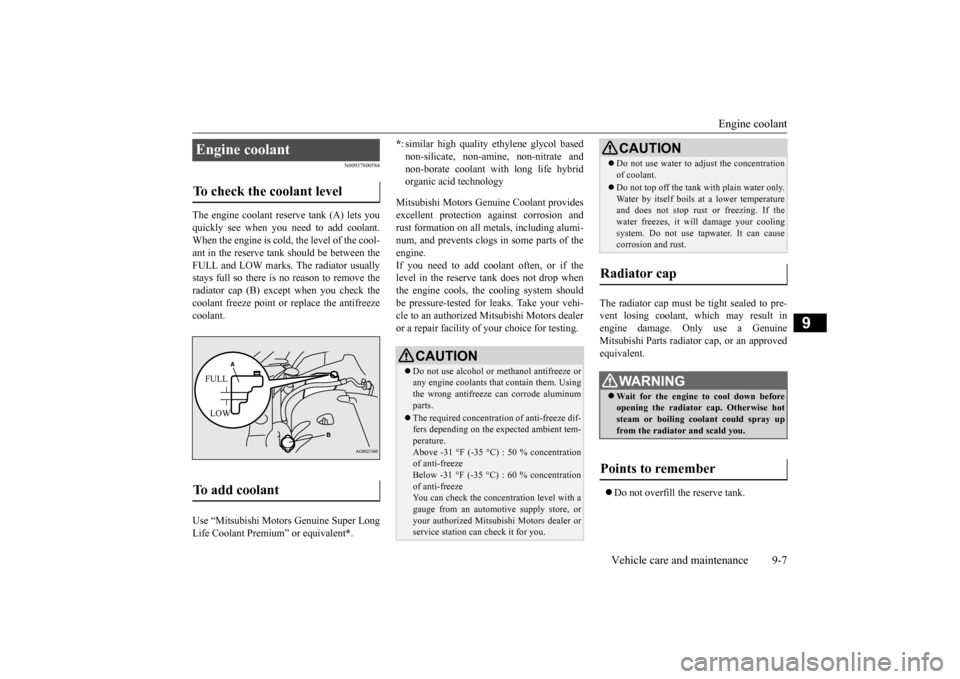
Engine coolant
Vehicle care and maintenance 9-7
9
N00937800584
The engine coolant reserve tank (A) lets you quickly see when you need to add coolant. When the engine is cold, the level of the cool-ant in the reserve tank should be between the FULL and LOW marks. The radiator usually stays full so there is no reason to remove theradiator cap (B) except when you check thecoolant freeze point or replace the antifreeze coolant.
Mitsubishi Motors Genuine Coolant provides excellent protection against corrosion and rust formation on all metals, including alumi- num, and prevents clogs in some parts of theengine. If you need to add co
olant often, or if the
level in the reserve tank does not drop whenthe engine cools, the cooling system shouldbe pressure-tested for leaks. Take your vehi- cle to an authorized
Mitsubishi Motors dealer
or a repair facility of your choice for testing.
The radiator cap must be tight sealed to pre- vent losing coolant, which may result in engine damage. Only use a GenuineMitsubishi Parts radiator cap, or an approved equivalent. Do not overfill the reserve tank.
Engine coolant To check the coolant level To add coolant Use “Mitsubishi Motors Genuine Super Long Life Coolant Premium” or equivalent
*.
FULL LOW
*: similar high quality ethylene glycol based non-silicate, non-amine, non-nitrate andnon-borate coolant with long life hybrid organic acid technologyCAUTION Do not use alcohol or methanol antifreeze or any engine coolants that contain them. Using the wrong antifreeze can corrode aluminumparts. The required concentration of anti-freeze dif- fers depending on the expected ambient tem- perature. Above -31 °F (-35 °C) : 50 % concentration of anti-freeze Below -31 °F (-35 °C) : 60 % concentrationof anti-freeze You can check the concentration level with a gauge from an automotive supply store, oryour authorized Mitsubishi Motors dealer or service station can check it for you.
Do not use water to adjust the concentration of coolant. Do not top off the tank with plain water only. Water by itself boils at a lower temperatureand does not stop rust or freezing. If the water freezes, it will damage your cooling system. Do not use tapwater. It can causecorrosion and rust.
Radiator cap
WA R N I N G Wait for the engine to cool down before opening the radiator cap. Otherwise hotsteam or boiling coolant could spray up from the radiator and scald you.
Points to remember
CAUTION
BK0202700US.bo
ok 7 ページ 2013年3月28日 木曜日 午前11時54分
Page 329 of 384
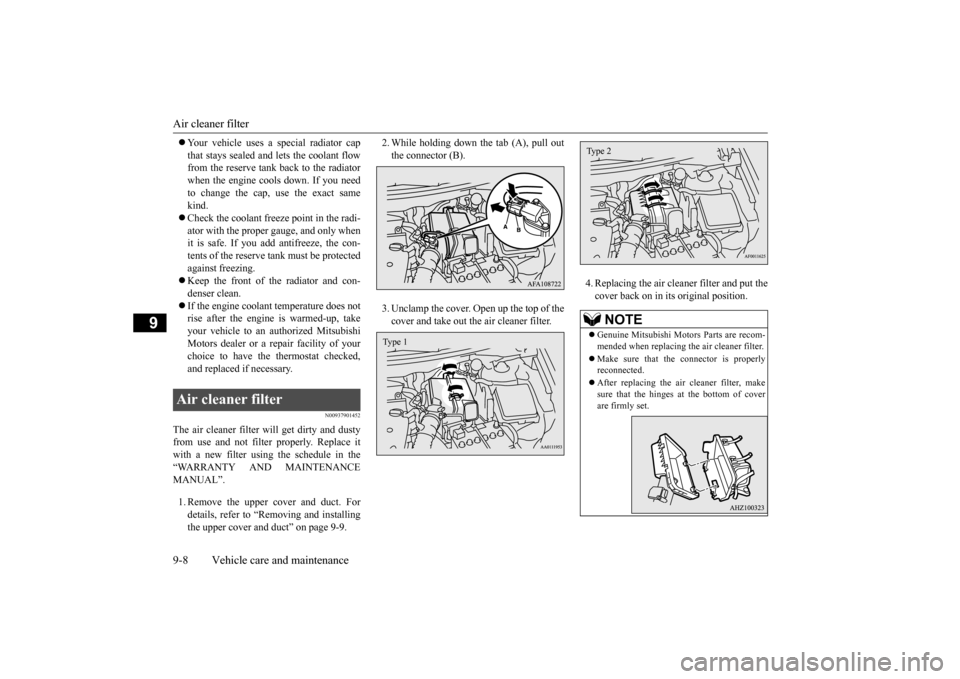
Air cleaner filter 9-8 Vehicle care and maintenance
9
Your vehicle uses a special radiator cap that stays sealed and lets the coolant flow from the reserve tank back to the radiator when the engine cools down. If you needto change the cap, use the exact same kind. Check the coolant freeze point in the radi- ator with the proper gauge, and only when it is safe. If you add antifreeze, the con- tents of the reserve tank must be protectedagainst freezing. Keep the front of the radiator and con- denser clean. If the engine coolant temperature does not rise after the engine is warmed-up, take your vehicle to an authorized Mitsubishi Motors dealer or a repair facility of yourchoice to have the thermostat checked, and replaced if necessary.
N00937901452
The air cleaner filter will get dirty and dustyfrom use and not filter properly. Replace it with a new filter using the schedule in the“WARRANTY AND MAINTENANCE MANUAL”. 1. Remove the upper cover and duct. For details, refer to “Removing and installingthe upper cover and duct” on page 9-9.
2. While holding down
the tab (A), pull out
the connector (B). 3. Unclamp the cover. Open up the top of the cover and take out the air cleaner filter.
4. Replacing the air cleaner filter and put the cover back on in its original position.
Air cleaner filter
Type 1
NOTE
Genuine Mitsubishi Moto
rs Parts are recom-
mended when replacing the air cleaner filter. Make sure that the connector is properly reconnected. After replacing the air cleaner filter, make sure that the hinges at the bottom of cover are firmly set.Type 2
BK0202700US.bo
ok 8 ページ 2013年3月28日 木曜日 午前11時54分
Page 330 of 384
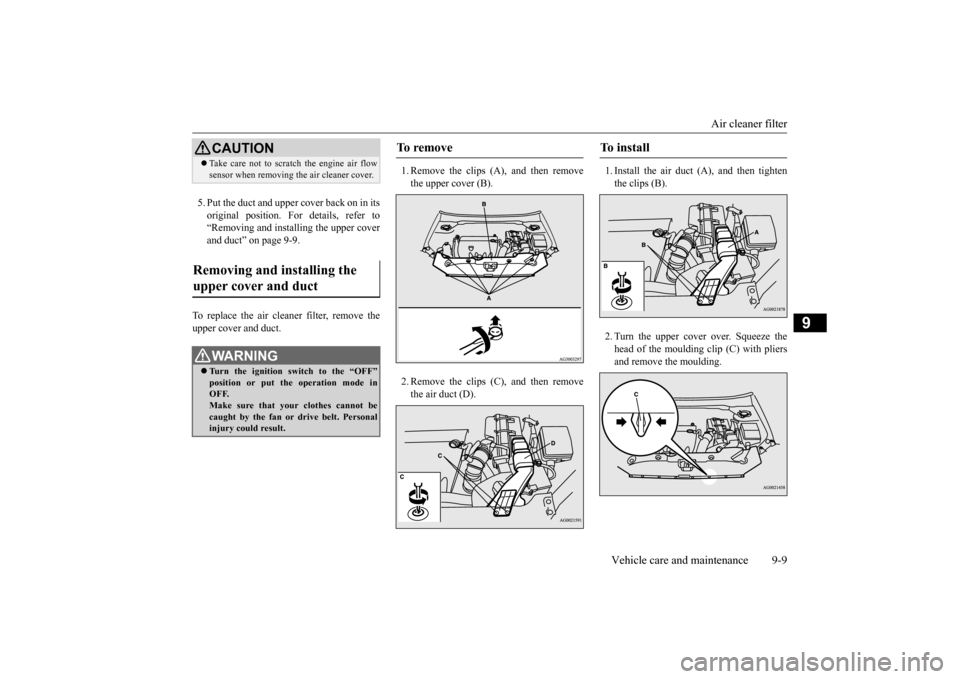
Air cleaner filter
Vehicle care and maintenance 9-9
9
5. Put the duct and upper cover back on in its original position. For details, refer to “Removing and installing the upper cover and duct” on page 9-9.
To replace the air cleaner filter, remove the upper cover and duct.
1. Remove the clips (A), and then remove the upper cover (B). 2. Remove the clips (C), and then remove the air duct (D).
1. Install the air duct
(A), and then tighten
the clips (B). 2. Turn the upper cover over. Squeeze the head of the moulding clip (C) with pliers and remove the moulding.
CAUTION Take care not to scratch the engine air flow sensor when removing the air cleaner cover.
Removing and installing the upper cover and duct
WA R N I N G Turn the ignition switch to the “OFF” position or put the operation mode in OFF.Make sure that your clothes cannot be caught by the fan or drive belt. Personal injury could result.
To remove
To install
BK0202700US.bo
ok 9 ページ 2013年3月28日 木曜日 午前11時54分
Page 331 of 384
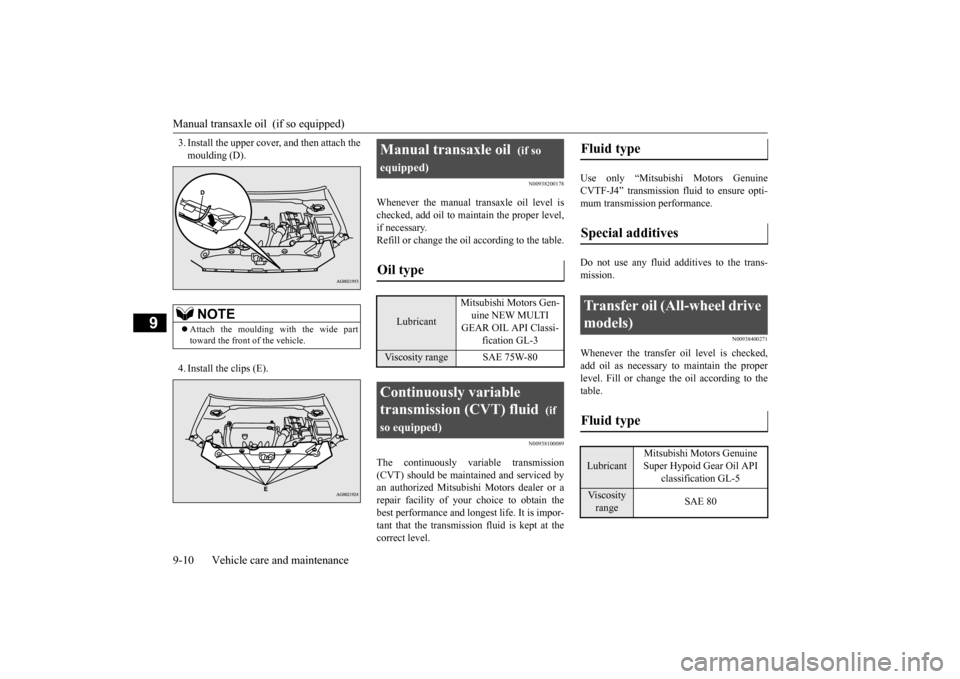
Manual transaxle oil (if so equipped) 9-10 Vehicle care and maintenance
9
3. Install the upper cover, and then attach the moulding (D). 4. Install the clips (E).
N00938200178
Whenever the manual transaxle oil level is checked, add oil to maintain the proper level, if necessary. Refill or change the oil according to the table.
N00938100089
The continuously variable transmission(CVT) should be maintained and serviced by an authorized Mitsubishi Motors dealer or a repair facility of your choice to obtain thebest performance and longest life. It is impor- tant that the transmission fluid is kept at the correct level.
Use only “Mitsubishi Motors Genuine CVTF-J4” transmission fluid to ensure opti-mum transmission performance. Do not use any fluid additives to the trans- mission.
N00938400271
Whenever the transfer oil level is checked,add oil as necessary to maintain the properlevel. Fill or change the oil according to the table.
NOTE
Attach the moulding with the wide part toward the front of the vehicle.
Manual transaxle oil
(if so
equipped)Oil type
Lubricant
Mitsubishi Motors Gen- uine NEW MULTI GEAR OIL API Classi-
fication GL-3
Viscosity range SAE 75W-80Continuously variable transmission (CVT) fluid
(if
so equipped)
Fluid type
Special additives
Transfer oil (All-wheel drive models) Fluid type Lubricant
Mitsubishi Motors Genuine Super Hypoid Gear Oil API
classification GL-5
Viscosity range
SAE 80
BK0202700US.bo
ok 10 ページ 2013年3月28日 木曜日 午前11時54分
Page 332 of 384
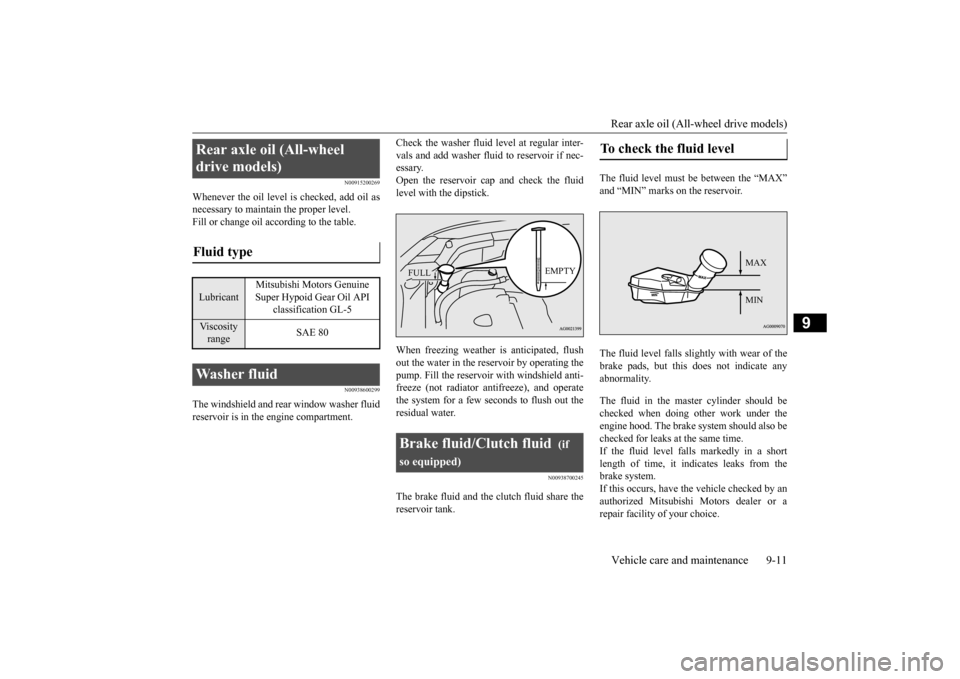
Rear axle oil (All-wheel drive models) Vehicle care and maintenance 9-11
9
N00915200269
Whenever the oil level is checked, add oil as necessary to maintain the proper level.Fill or change oil according to the table.
N00938600299
The windshield and rear window washer fluidreservoir is in the engine compartment.
Check the washer fluid level at regular inter- vals and add washer fluid to reservoir if nec- essary. Open the reservoir cap and check the fluidlevel with the dipstick. When freezing weather is anticipated, flush out the water in the reservoir by operating the pump. Fill the reservoir with windshield anti-freeze (not radiator antifreeze), and operatethe system for a few seconds to flush out the residual water.
N00938700245
The brake fluid and the clutch fluid share the reservoir tank.
The fluid level must be between the “MAX” and “MIN” marks on the reservoir. The fluid level falls slightly with wear of the brake pads, but this does not indicate any abnormality. The fluid in the master cylinder should be checked when doing other work under theengine hood. The brake
system should also be
checked for leaks at the same time. If the fluid level falls markedly in a shortlength of time, it indicates leaks from the brake system. If this occurs, have the vehicle checked by anauthorized Mitsubishi Motors dealer or a repair facility of your choice.
Rear axle oil (All-wheel drive models) Fluid type Lubricant
Mitsubishi Motors Genuine Super Hypoid Gear Oil API
classification GL-5
Viscosity range
SAE 80
Washer fluid
Brake fluid/Clutch fluid
(if
so equipped)FULL
EMPTY
To check the fluid level
MAX MIN
BK0202700US.bo
ok 11 ページ 2013年3月28日 木曜日 午前11時54分
Page 333 of 384
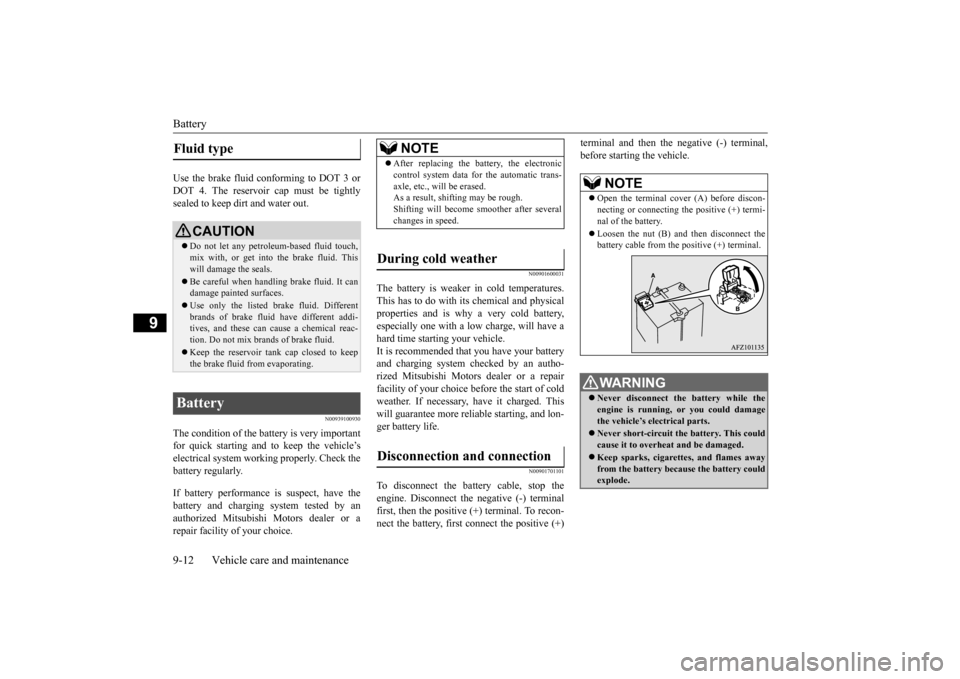
Battery 9-12 Vehicle care and maintenance
9
Use the brake fluid conforming to DOT 3 or DOT 4. The reservoir cap must be tightlysealed to keep dirt and water out.
N00939100930
The condition of the battery is very important for quick starting and to keep the vehicle’s electrical system working properly. Check thebattery regularly. If battery performance is suspect, have the battery and charging system tested by an authorized Mitsubishi Motors dealer or arepair facility of your choice.
N00901600031
The battery is weaker in cold temperatures.This has to do with its chemical and physicalproperties and is why a very cold battery, especially one with a low charge, will have a hard time starting your vehicle.It is recommended that you have your battery and charging system checked by an autho- rized Mitsubishi Motors dealer or a repairfacility of your choice before the start of cold weather. If necessary, have it charged. This will guarantee more reliable starting, and lon-ger battery life.
N00901701101
To disconnect the battery cable, stop theengine. Disconnect the negative (-) terminal first, then the positive (+) terminal. To recon- nect the battery, first connect the positive (+)
terminal and then the negative (-) terminal, before starting the vehicle.
Fluid type
CAUTION Do not let any petroleum-based fluid touch, mix with, or get into the brake fluid. This will damage the seals. Be careful when handling brake fluid. It can damage painted surfaces. Use only the listed brake fluid. Different brands of brake fluid have different addi-tives, and these can cause a chemical reac- tion. Do not mix brands of brake fluid. Keep the reservoir tank cap closed to keep the brake fluid from evaporating.
Battery
NOTE
After replacing the battery, the electronic control system data for the automatic trans- axle, etc., will be erased. As a result, shifting may be rough. Shifting will become smoother after severalchanges in speed.
During cold weather Disconnection and connection
NOTE
Open the terminal cover (A) before discon- necting or connecting the positive (+) termi- nal of the battery. Loosen the nut (B) and then disconnect the battery cable from the positive (+) terminal.WA R N I N G Never disconnect the battery while the engine is running, or you could damage the vehicle’s electrical parts. Never short-circuit the battery. This could cause it to overheat and be damaged. Keep sparks, cigarettes, and flames away from the battery because the battery couldexplode.
BK0202700US.bo
ok 12 ページ 2013年3月28日 木曜日 午前11時54分
Page 334 of 384
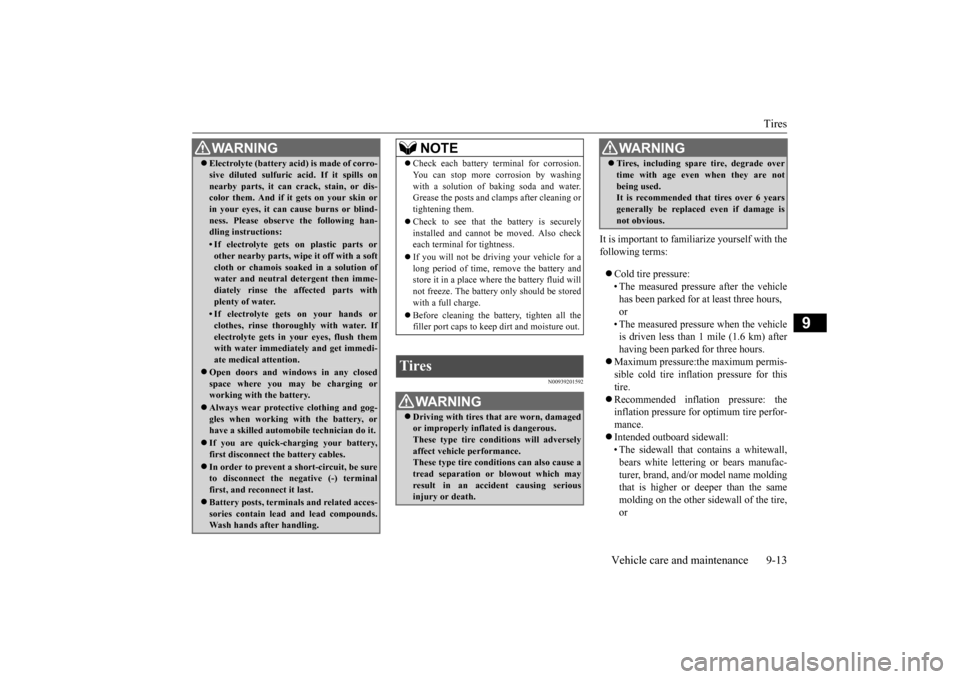
Tires
Vehicle care and maintenance 9-13
9
N00939201592
It is important to familiarize yourself with the following terms: Cold tire pressure: • The measured pressure after the vehicle has been parked for at least three hours,or • The measured pressure when the vehicle is driven less than 1 mile (1.6 km) afterhaving been parked for three hours.
Maximum pressure:the maximum permis- sible cold tire inflation pressure for thistire. Recommended inflation pressure: the inflation pressure for optimum tire perfor-mance. Intended outboard sidewall: • The sidewall that contains a whitewall,bears white lettering or bears manufac- turer, brand, and/or model name molding that is higher or deeper than the samemolding on the other sidewall of the tire, or
Electrolyte (battery acid) is made of corro- sive diluted sulfuric
acid. If it spills on
nearby parts, it can crack, stain, or dis- color them. And if it gets on your skin or in your eyes, it can cause burns or blind-ness. Please observe the following han- dling instructions:• If electrolyte gets on plastic parts orother nearby parts, wipe it off with a soft cloth or chamois soaked in a solution ofwater and neutral detergent then imme- diately rinse the affected parts with plenty of water.• If electrolyte gets on your hands orclothes, rinse thoroughly with water. Ifelectrolyte gets in your eyes, flush them with water immediately and get immedi- ate medical attention.
Open doors and windows in any closed space where you may be charging orworking with the battery. Always wear protective clothing and gog- gles when working with the battery, or have a skilled automobile technician do it. If you are quick-charging your battery, first disconnect th
e battery cables.
In order to prevent a short-circuit, be sure to disconnect the negative (-) terminal first, and reconnect it last. Battery posts, terminals and related acces- sories contain lead and lead compounds. Wash hands after handling.WA R N I N G
NOTE
Check each battery terminal for corrosion. You can stop more corrosion by washing with a solution of baking soda and water. Grease the posts and clamps after cleaning or tightening them. Check to see that the battery is securely installed and cannot be moved. Also checkeach terminal for tightness. If you will not be driving your vehicle for a long period of time, remove the battery and store it in a place where the battery fluid will not freeze. The battery only should be storedwith a full charge. Before cleaning the battery, tighten all the filler port caps to keep dirt and moisture out.
Tires
WA R N I N G Driving with tires that are worn, damaged or improperly inflated is dangerous.These type tire conditions will adversely affect vehicle performance. These type tire conditions can also cause a tread separation or blowout which may result in an accident causing seriousinjury or death.
Tires, including spare tire, degrade over time with age even when they are not being used. It is recommended that tires over 6 years generally be replaced even if damage isnot obvious.WA R N I N G
BK0202700US.bo
ok 13 ページ 2013年3月28日 木曜日 午前11時54分
Page 335 of 384
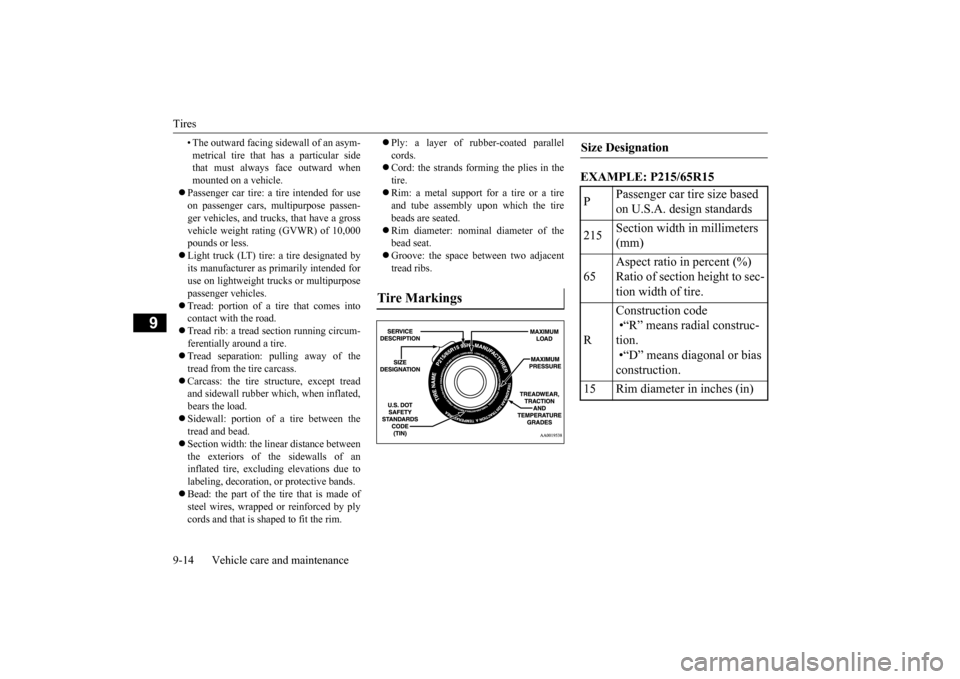
Tires 9-14 Vehicle care and maintenance
9
• The outward facing sidewall of an asym- metrical tire that has a particular side that must always face outward when mounted on a vehicle.
Passenger car tire: a tire intended for use on passenger cars, multipurpose passen- ger vehicles, and trucks, that have a grossvehicle weight rating (GVWR) of 10,000 pounds or less. Light truck (LT) tire: a tire designated by its manufacturer as primarily intended foruse on lightweight trucks or multipurpose passenger vehicles. Tread: portion of a tire that comes into contact with the road. Tread rib: a tread section running circum- ferentially around a tire. Tread separation: pulling away of the tread from the tire carcass. Carcass: the tire structure, except tread and sidewall rubber which, when inflated, bears the load. Sidewall: portion of a tire between the tread and bead. Section width: the linear distance between the exteriors of the sidewalls of aninflated tire, excluding elevations due to labeling, decoration, or protective bands. Bead: the part of the tire that is made of steel wires, wrapped or reinforced by ply cords and that is shaped to fit the rim.
Ply: a layer of rubber-coated parallel cords. Cord: the strands forming the plies in the tire. Rim: a metal support for a tire or a tire and tube assembly upon which the tire beads are seated. Rim diameter: nominal diameter of the bead seat. Groove: the space between two adjacent tread ribs.
EXAMPLE: P215/65R15
Tire Markings
Size Designation P
Passenger car tire size based on U.S.A. design standards
215
Section width in millimeters (mm)
65
Aspect ratio in percent (%) Ratio of section height to sec- tion width of tire.
R
Construction code •“R” means radial construc-tion. •“D” means diagonal or bias construction.
15 Rim diameter in inches (in)
BK0202700US.bo
ok 14 ページ 2013年3月28日 木曜日 午前11時54分
Page 336 of 384
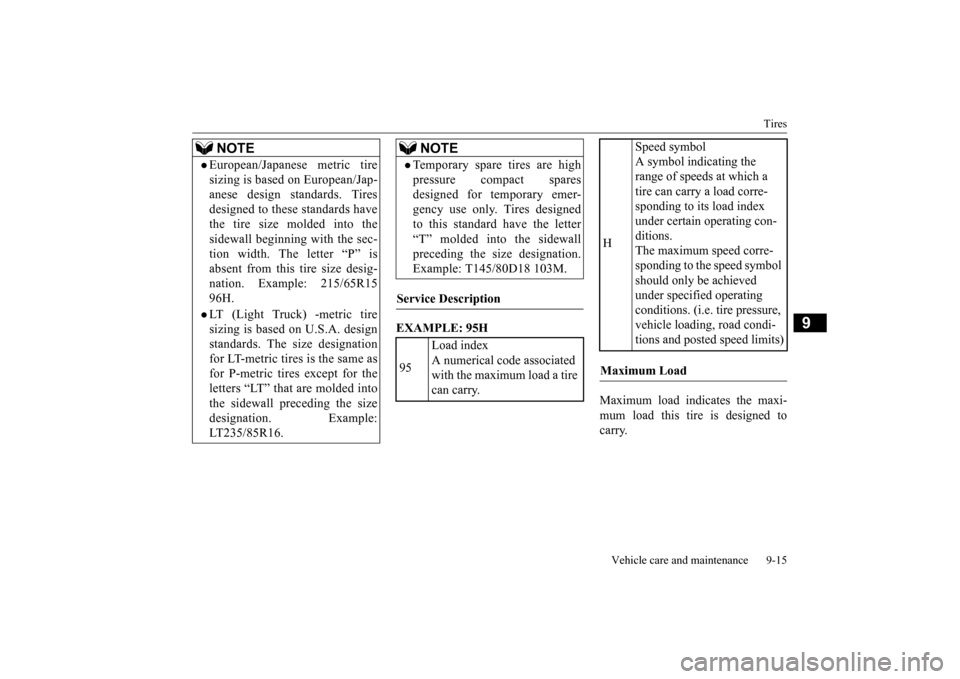
Tires
Vehicle care and maintenance 9-15
9
EXAMPLE: 95H
Maximum load indicates the maxi- mum load this tire is designed to carry.
NOTE
European/Japanese metric tire sizing is based on European/Jap- anese design standards. Tiresdesigned to these standards have the tire size molded into the sidewall beginning with the sec-tion width. The letter “P” is absent from this tire size desig- nation. Example: 215/65R1596H.LT (Light Truck) -metric tiresizing is based on U.S.A. design standards. The size designation for LT-metric tires is the same asfor P-metric tires except for the letters “LT” that are molded into the sidewall preceding the sizedesignation. Example: LT235/85R16.
Temporary spare tires are highpressure compact spares designed for temporary emer-gency use only. Tires designed to this standard have the letter “T” molded into the sidewallpreceding the size designation. Example: T145/80D18 103M.
Service Description 95
Load index A numerical code associated with the maximum load a tire can carry.NOTE
H
Speed symbol A symbol indicating the range of speeds at which a tire can carry a load corre-sponding to its load index under certain operating con- ditions.The maximum speed corre- sponding to the speed symbol should only be achieved under specified operating conditions. (i.e. tire pressure, vehicle loading, road condi-tions and posted speed limits)
Maximum Load
BK0202700US.bo
ok 15 ページ 2013年3月28日 木曜日 午前11時54分